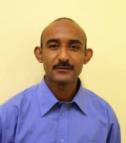
Biography:
Hisham Y. Hassan, MSc., PhD., graduated at the Department of Zoology, Faculty of Science, University of Khartoum with honors in Zoology. In 2003, he joined the Institute of Endemic Diseases, University of Khartoum, to do his master degree in molecular biology. His study addresses diverse aspects of molecular archeology and population genetics, during the first year he managed to carry out a unique study on genetic patterns of Y-chromosome and mitochondrial DNA variation, with implications to the peopling of the Sudan, and according to the potential scientific value of the data his registration has been upgraded to the degree of doctoral of philosophy. He was awarded his PhD in molecular biology in 2009. Now he is the Secretary General of the Sudanese Academy of Young Scientists (SAYS), and an associate editor in the editorial board of SAYS newsletter.
Abstract:
Mitochondrial DNA of Sudanese: in situ Evolution versus Gene Flow?
Variation in mtDNA provides a reliable record of the maternal lineage of human species; and studies of mitochondrial DNA (mtDNA) variation indicate that African populations have a rich and important history from which we can learn much about our origins as a species. To study the mtDNA variation in Sudan, 404 unrelated individuals in 15 Sudanese populations representing the three linguistic families were sequenced for the mitochondrial control region. For mtDNA analysis, a total of 56 haplotypes were observed, all belonging to the major sub-Saharan African and Eurasian mitochondrial macrohaplogroups L0, L1, L2, L4, L5, L3A, M and N in frequencies of 12.1, 11.9, 22, 4.2, 6.2, 29.5, 2, and 12.2% respectively. The considerable frequencies of haplogroup L0 in Sudan is interesting given the fact that this haplogroup occurs near the root of the mitochondrial DNA tree, and this haplogroup is shared among groups in south, west and northern Sudan, thus providing evidence on the affinities of these particular groups. Afro-Asiatic speaking groups appear to have sustained high gene flow form Nilo-Saharan speaking groups. Mantel test reveal no correlations between genetic, linguistic (r = 0.12, p = 0.14), and geographic distances (r = -0.07, p = 0.67). Sudanese mitochondrial gene pool showed wide and deep regional variation, and the diversity in mtDNA sequences in Sudan is likely to have been shaped by a longer history of in-situ evolution and then by human migrations form East, west-central and North Africa and to a lesser extent from Eurasia to the Nile Valley.
The next generation, and the process of change and adaptation continues. Ultimately, a "division of labor" occurs through speciation (i.e. divergence of a single species into two or more new species), complex ecological systems arise -- and to the logical extreme, a global network of life-forms.